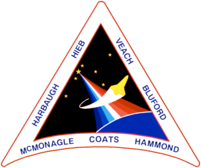STS-39
| Missionsemblem | |||||
|---|---|---|---|---|---|
 | |||||
| Missionsstatistik | |||||
| Missionsnavn: | STS-39 | ||||
| Rumagentur: | NASA | ||||
| Rumfærge: | Discovery (12) | ||||
| Antal besætningsmedlemmer: | 7 | ||||
| Affyringsrampe: | LC-39A (KSC) | ||||
| Opsendelse: | 28. april 1991 | ||||
| Landing: | 6. maj 1991 | ||||
| Landet på: | KSC | ||||
| Varighed: | 8 døgn og 7 timer | ||||
| Foto af besætningen | |||||
 | |||||
| Navigation | |||||
| |||||
STS-39 (Space Transportation System-38) var rumfærgen Discovery 12. rumfærge-mission. Den blev opsendt d. 28. april 1991 og vendte tilbage den 6. maj 1991.
Missionen medbragte delvis klassificeret militær last for Forsvarsministeriet (USA) (DoD).
Hovedartikler:
Besætning

 Michael Coats (kaptajn)
Michael Coats (kaptajn)
 Blaine Hammond (pilot)
Blaine Hammond (pilot)
 Guion Bluford (1. missionsspecialist)
Guion Bluford (1. missionsspecialist)
 Gregory Harbaugh (2. missionsspecialist)
Gregory Harbaugh (2. missionsspecialist)
 Richard Hieb (3. missionsspecialist)
Richard Hieb (3. missionsspecialist)
 Donald McMonagle (4. missionsspecialist)
Donald McMonagle (4. missionsspecialist)
 Charles Veach (5. missionsspecialist)
Charles Veach (5. missionsspecialist)
Missionen
Missionen medbragte følgende nyttelast:
- Air Force Program-675 (AFP675)
- Infrared Background Signature Survey (IBSS) [1]
- Critical Ionization Velocity (CIV)
- Chemical Release Observation (CRO)
- Shuttle Pallet Satellite-II (SPAS-II) experiments;
- Space Test Payload-1 (STP-1)
- Klassificeret last
- Multi-Purpose Release Canister (MPEC)
- Radiation Monitoring Equipment III (RME III)
- Cloud Logic til optimering af forsvarssystemet (CLOUDS-I).
Eksterne henvisninger
- STS-39 NASA (engelsk)
- STS-39 Arkiveret 25. juli 2010 hos Wayback Machine NASA KSC (engelsk)
- ^ Data Analysis of IBSS and Cirris-1A Data Collected During STS-39 Arkiveret 1. november 2004 hos Wayback Machine Storming Media
| ||||||||
Medier brugt på denne side
Forfatter/Opretter: Kwamikagami, Licens: CC BY-SA 4.0
symbol of Mars. 16 × 16 pixel nominal dimensions, lines 2 pixel thick, square caps. Colour 75% blue: red=0 green=0 blue=191 (#0000BF).
Rotated and color enhanced version of original (ISS013-E-48788 (6 July 2006) --- The Space Shuttle Discovery approaches the International Space Station for docking but before the link-up occurred, the orbiter "posed" for a thorough series of inspection photos. Leonardo Multipurpose Logistics Module can be seen in the shuttle's cargo bay. Discovery docked at the station's Pressurized Mating Adapter 2 at 9:52 a.m. CDT, July 6, 2006.)
The STS-39 crew portrait includes 7 astronauts. Pictured are Charles L. Veach, mission specialist 5; Michael L. Coats, commander; Gregory J. Harbaugh, mission specialist 2; Donald R. McMonagle, mission specialist 4; L. Blaine Hammond, pilot; Richard J. Hieb, mission specialist 3; and Guion S. Buford, Jr., mission specialist 1. Launched aboard the Space Shuttle Discovery on April 28, 1991 at 7:33:14 am (EDT), STS-39 was a Department of Defense (DOD) mission. The primary unclassified payload included the Air Force Program 675 (AFP-675), the Infrared Background Signature Survey (IBSS), and the Shuttle Pallet Satellite II (SPAS II).
STS-40 Mission Insignia
STS-37 Mission Insignia
STS-39 Mission Insignia
STS039-09-036 (28 April-6 May 1991) --- Astronaut Charles L. (Lacy) Veach monitors experiment data on the aft flight deck of the Earth-orbiting Discovery. The photograph was taken with a 35mm camera. Veach and six other NASA astronauts spent over eight days in space busily collecting data for this mission, dedicated to the Department of Defense.
Aurora Australis: This view of the Aurora Australis, or Southern Lights, which was photographed by an astronaut aboard Space Shuttle Discovery (STS-39) in 1991, shows a spiked band of red and green aurora above the Earth's Limb. Calculated to be at altitudes ranging from 80 - 120 km (approx. 50-80 miles), the auroral light shown is due to the "excitation" of atomic oxygen in the upper atmosphere by charged particles (electrons) streaming down from the magnetosphere above. Credit: NASA











